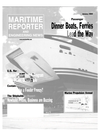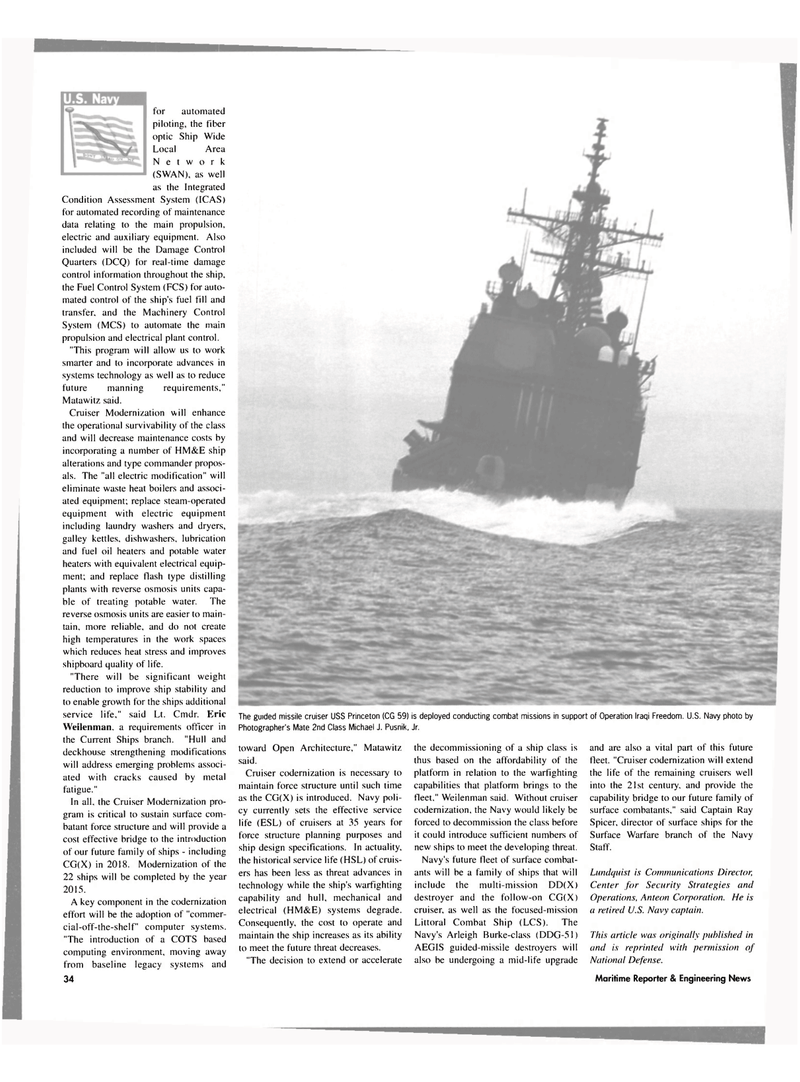
Page 34: of Maritime Reporter Magazine (January 2004)
Ferry & Passenger Vessel Yearbook
Read this page in Pdf, Flash or Html5 edition of January 2004 Maritime Reporter Magazine
for automated piloting, the fiber optic Ship Wide
Local Area
Network (SWAN), as well as the Integrated
Condition Assessment System (ICAS) for automated recording of maintenance data relating to the main propulsion, electric and auxiliary equipment. Also included will be the Damage Control
Quarters (DCQ) for real-time damage control information throughout the ship, the Fuel Control System (FCS) for auto- mated control of the ship's fuel fill and transfer, and the Machinery Control
System (MCS) to automate the main propulsion and electrical plant control. "This program will allow us to work smarter and to incorporate advances in systems technology as well as to reduce future manning requirements,"
Matawitz said.
Cruiser Modernization will enhance the operational survivability of the class and will decrease maintenance costs by incorporating a number of HM&E ship alterations and type commander propos- als. The "all electric modification" will eliminate waste heat boilers and associ- ated equipment; replace steam-operated equipment with electric equipment including laundry washers and dryers, galley kettles, dishwashers, lubrication and fuel oil heaters and potable water heaters with equivalent electrical equip- ment; and replace flash type distilling plants with reverse osmosis units capa- ble of treating potable water. The reverse osmosis units are easier to main- tain, more reliable, and do not create high temperatures in the work spaces which reduces heat stress and improves shipboard quality of life. "There will be significant weight reduction to improve ship stability and to enable growth for the ships additional service life," said Lt. Cmdr. Eric
Weilenman, a requirements officer in the Current Ships branch. "Hull and deckhouse strengthening modifications will address emerging problems associ- ated with cracks caused by metal fatigue."
In all. the Cruiser Modernization pro- gram is critical to sustain surface com- batant force structure and will provide a cost effective bridge to the introduction of our future family of ships - including
CG(X) in 2018. Modernization of the 22 ships will be completed by the year 2015.
A key component in the codernization effort will be the adoption of "commer- cial-off-the-shelf" computer systems. "The introduction of a COTS based computing environment, moving away from baseline legacy systems and 34
The guided missile cruiser USS Princeton (CG 59) is deployed conducting combat missions in support of Operation Iraqi Freedom. U.S. Navy photo by
Photographer's Mate 2nd Class Michael J. Pusnik, Jr. toward Open Architecture," Matawitz said.
Cruiser codernization is necessary to maintain force structure until such time as the CG(X) is introduced. Navy poli- cy currently sets the effective service life (ESL) of cruisers at 35 years for force structure planning purposes and ship design specifications. In actuality, the historical service life (HSL) of cruis- ers has been less as threat advances in technology while the ship's warfighting capability and hull, mechanical and electrical (HM&E) systems degrade.
Consequently, the cost to operate and maintain the ship increases as its ability to meet the future threat decreases. "The decision to extend or accelerate the decommissioning of a ship class is thus based on the affordability of the platform in relation to the warfighting capabilities that platform brings to the fleet," Weilenman said. Without cruiser codernization, the Navy would likely be forced to decommission the class before it could introduce sufficient numbers of new ships to meet the developing threat.
Navy's future fleet of surface combat- ants will be a family of ships that will include the multi-mission DD(X) destroyer and the follow-on CG(X) cruiser, as well as the focused-mission
Littoral Combat Ship (LCS). The
Navy's Arleigh Burke-class (DDG-51)
AEGIS guided-missile destroyers will also be undergoing a mid-life upgrade and are also a vital part of this future fleet. "Cruiser codernization will extend the life of the remaining cruisers well into the 21st century, and provide the capability bridge to our future family of surface combatants," said Captain Ray
Spicer, director of surface ships for the
Surface Warfare branch of the Navy
Staff.
Lundquist is Communications Director,
Center for Security Strategies and
Operations, Anteon Corporation. He is a retired U.S. Navy captain.
This article was originally published in and is reprinted with permission of
National Defense. 36 Maritime Reporter & Engineering News

 33
33

 35
35
